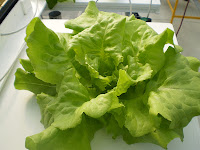Variety Trial Report- Summer/Fall 2012
CropKing Research Greenhouse- Lodi, OH Cultivar Report 12.1
Cultivar Report 12.1- Butterhead Trial Report
Dr. Natalie Bumgarner
Objective
Hydroponic lettuce production in the
United States now encompasses a wide spectrum of lettuce types and
cultivars. Producers desire both attractive and distinctive crop
cultivars to meet consumer demand, but consistency in both
productivity and timing is still a key in the industry. Many facets
of hydroponic lettuce production are impacted by seasonal conditions.
One of the most important environmental impact of season is the
growth rate of the plant. Growth rate is the driver of productivity
and determines crop timing and the number of crops a grower can
produce each year. Additionally, crop quality aspects, such as
coloration and physiological defects (tipburn) are often influenced
by seasonal conditions. Therefore, trialing of available varieties
under differing environmental conditions as influenced by seasons are
important in informing grower decisions. The goal of this set of
trials was to evaluate a selection of bibb lettuce cultivars through
a range of late summer to mid-winter conditions to evaluate their
potential for growers producing fall to winter. Cultivars were
obtained from a variety of seed suppliers to represent a broad
selection of bibb cultivars available to US lettuce producers.
Materials and Methods
Plant Management-
All plants were grown for the entirety
of the crop in the CropKing research greenhouse in Lodi, OH. Primed
and pelleted seeds were seeded by hand in pre-moistened (with pH
adjusted water) 1” x 1” x 1 ½” rockwool cubes. Seeds were
germinated uncovered in clear water in seeding trays in the CropKing
nursery area. Nutrient solution was added in the nursery 7 days after
seeding. Seedlings were produced in flowing nutrient solution as
described below for an additional week prior to transplanting.
Transplanting occurred two weeks after seeding. After transplanting,
lettuce plants were grown out in the channel for four weeks prior to
harvest. Total production time was six weeks.
Growing System-
After transplanting, lettuce was
produced to harvest in CropKing NFT channels. These 4” wide growing
channels are food-grade, UV resistant PVC with matching top caps
punched to fit rockwool or other similar growing mediums. Spacing for
plant production is 8” within and across channels. All channels are
fed by nutrient feed lines supplied a continually recirculating
nutrient solution. Each channel drains into a completely closed drain
line which returns the nutrient solution to the reservoir. Galvanized
steel frames support the channels and the drain line. Solution is
also continually cycled through the CropKing Fertroller where
automatic pH and EC adjustment is carried out to meet programmed
solution setpoints. The pH was maintained at 5.8 by the addition of
dilute sulfuric acid. EC was maintained at 1.8 by the addition of
concentrated fertilizer solution and source water.
Greenhouse Conditions-
| Air temp. average (°F) | Relative Humidity average (%) | Solar radiation average (W/m2)* | Carbon dioxide (ppm) | |
| 8/8 to 9/20 trial |
70.1
|
81.9
|
141.9
|
461.4
|
| 9/12 to 10/23 trial |
68.6
|
70.7
|
131.2
|
445.4
|
*40%
white shade cloth was in place from 8/8 through 9/14 when it was
removed. Thus solar radiation averages reflect reductions in light
transmission provided by the shade cloth.
Nutrient Solution
Formulation-
Nutrient solution was supplied by the
Fertroller system discussed above. Stock solutions #1 and #2 were
prepared using greenhouse grade calcium nitrate, potassium nitrate,
magnesium sulfate, monopotassium phosphate, DTPA iron chelate, and
CropKing MicroMix. Nutrient solution formulation was based on
laboratory results from on-site samples of source was and were
intended to reach macro and micronutrient targets specific for leafy
crops in NFT systems.
Results
|
Discussion
These two lettuce crops
were produced on the same production cycle with consistent days to
transplant and harvest. The yield data illustrate potential seasonal
effects of decreasing light as the light intensity and day length
tend to decline during fall in this northern latitude. Temperature
differences, even of a few degrees, in these two runs of the trial
could also have influenced final harvest yields. Additionally, it
should be noted that reduced biomass was more pronounced in some
cultivars than other indicating that some cultivars may be suitable
for year-round production while others have seasons when production
is optimized.



























